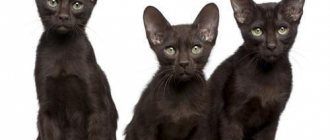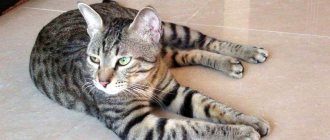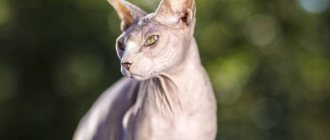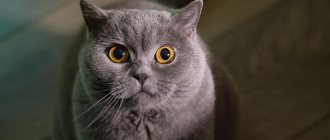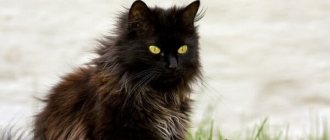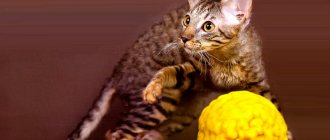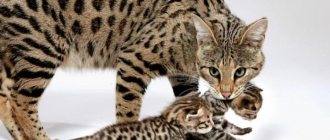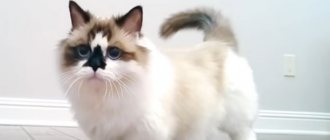Keeping a Celtic cat
Animals adapt to any, even Spartan, conditions. EKSH are neat, clean and do not tend to tear up walls/sofas. Toys with moving mechanisms will help satisfy hunting inclinations.
Care and hygiene
Thanks to their outdoor background, these cats require less care than others. Nature has endowed them with short hair so that dirt and parasites do not linger in it, and most EKSH cannot tolerate bath procedures. Only show-class animals that will show off at exhibitions are bathed.
The rest of the cats lick themselves, allowing the owners only to periodically comb out the hair that falls out (especially when molting). Innate cleanliness contributes to rapid adaptation to the tray, whose contents must be removed immediately. Those cats who go outside have even fewer problems with the toilet, but their ears need to be examined more often, where ear mites appear. If necessary, wipe the ears and eyes with a damp cotton swab and saline solution.
Celtic cat diet
The European Shorthair has no special food requirements. Kittens up to 3 months are fed (with an emphasis on dairy products) 6 times a day, after 4 months they are transferred to 2 meals a day. The Celtic cat can easily adapt to commercial food (dry and wet) labeled “super-premium” or “holistic”.
Pelleted food goes well with a natural diet. For the latter we recommend:
- meat (raw and cooked);
- sea fish (fresh and boiled);
- vegetables (in various forms, except fried);
- eggs;
- fermented milk products;
- porridge.
The menu should not be dominated by carbohydrates: a cat, like any predator, needs animal proteins. In addition, raw/solid foods will benefit from helping to clear away plaque.
Diseases and breed defects
Perhaps this is one of the rare cat breeds whose body does not suffer from hereditary diseases. The immunity of the Celtic cat has been forged over centuries and has not been spoiled by the noble blood of other, often pampered breeds. The only source of danger for EKSH are considered to be infections that even a cat sitting in an apartment can pick up: bacteria/viruses enter the house along with clothes and shoes.
The first vaccinations for kittens are given at 8 weeks (if the cat was not vaccinated before birth) or at 12 weeks (with prenatal vaccination). 10 days before immunization, kittens are dewormed.
Description of the Celtic cat (standard requirements)
In the early 80s of the last century, the Celtic cat was recognized as an independent breed. European Shorthairs have their own special standards, which can be determined by the following characteristics:
- A medium-sized round head with widely spaced ears. Possible tassels at the ends. The height and width of the ears are equal. The nose is straight. Fluffy cheeks are prominent. The neck is muscular.
- The eyes are set wide, slightly slanted. The iris has the same color as the color of the cat: gray cats have a bluish look, red cats have a honey-colored look, only black cats will have green eyes.
- The legs are strong and long. The tail is proportional in size to the body, wide at the base, tapering towards the end.
- The coat is short, shiny, thick.
- A notable feature in the development of cats of the Celtic breed is manifested in the small size of “childhood” and significant physical growth in adulthood. The weight of an individual reaches 8 kg. The kitten turns into a large, strong animal.
- The color of cats is highly variable: gray, golden, marbled, motley. Chocolate-colored colors, white, and purple are excluded.
According to standard descriptions of the Celtic cat breed, their endurance and rare infectious diseases are noted. Animals are not aggressive if their lives are safe. Life expectancy is 16-20 years.
Features of behavior
Of course, each cat is different from others to one degree or another and has its own character. But representatives of the same breed still have common features. As a rule, European Shorthairs are smart, very affectionate and quiet cats. They quickly adapt to new conditions and are unpretentious. They almost immediately become attached to their owner and love him very much and are devoted to him.
But it happens that among quiet people there are energetic restless ones who love to play and be naughty. They are quite unpredictable. People who value the natural instincts of cats will find them comfortable and not boring.
They are quite delicate and are not intrusive. Only something serious can make them angry - like a real threat to life. Very, very inquisitive.
They do not consider a person to be a master; for them, he is rather a neighbor, a partner. They do not demonstrate their feelings, they are extremely restrained.
Features of character and behavior
They gained their popularity because of their temperament. These individuals are perfect for homes and families with children. These cats are active, love to play with their owner, and are cheerful. One distinctive feature of the “Celts” is the redness of the ears, nose, and skin on the paws in case of fear.
Even in particularly stressful circumstances, they will not show aggression, bite or scratch. In extreme cases, they may hiss. This makes this breed completely safe for children. These animals are not too intrusive and do not require special attention. If a person is not at home, the pet will find entertainment for itself. This is why you should buy toys.
When entering the house, the cat quickly adapts to the new rules of behavior established by the owner. They like to walk along the street, but they need to be accustomed to a harness or habit gradually.
If the pet lives in a private house, it will be happy to walk on its own. These cats rarely get lost; they are well versed in the area and will find their way home without any problems.
Personality of European Shorthair cats
This breed is ideal for those looking for an affectionate and intelligent four-legged friend. When an animal finds itself in a new place for the first time, it may begin to hide. This is a natural reaction to stress from a change of environment, but it passes quickly, and in a short period the cat fully adapts to the new home.
Independence is not the main feature of this cat, but it still occurs in a few representatives. They are mostly playful and cheerful creatures. You can easily go to work, leaving your cat alone at home; it does not require much attention. Pets do an excellent job of entertaining themselves on their own and do not suffer from loneliness at all.
An amazing feature of the breed can be considered the ability to blush - this is how cats get nervous. The nose and toes become red. Along with this, they also sweat
It is very important that European Shorthairs under no circumstances rush at people or scratch themselves. They only hiss, but never bite, so for small children such an animal will be an ideal companion.
Contact and friendliness are what distinguish shorthaired Europeans. If you don't want to interact with this cat, she will never bother you. This animal delights with its easy character and tact.
Features of the breed and character of the Celtic cat
The second name of the Celtic breed is European Shorthair. For many centuries, cats have lived next to humans in both city apartments and village farmsteads. The history of the formation of the breed laid the foundation for strong immunity to infections and excellent health for its representatives.
At first glance, the usual simplicity of appearance does not make an impression. Cats just seem ordinary and nondescript. When communicating with animals, their captivating naturalness and straightforwardness are revealed - this is precisely the value of the breed. It is no coincidence that recently Celtic shorthair cats have been actively represented at many exhibitions.
The movement, gait, and manners reveal the amazing grace of the animal, which no photograph can convey. The silent steps of first the left and then the right legs in a characteristic alternation attract attention.
The feigned imposingness of cats does not reflect the affection and manifestations of feelings of these affectionate and faithful pussies. Among people they behave as equals. Some people consider cats to be proud, even arrogant.
The secret is that the animal behaves selectively towards the people around it. The Celts choose themselves with whom they want to communicate and show tender feelings. They do not allow themselves to be treated with disdain. The choice of a beloved owner determines the pet’s lifestyle: it will follow on its heels, adopt habits, and wait for attention.
Vivid hunting instincts are the main feature of the breed, for which breeders value them so much. This determines their active, playful character. The objects of hunting can be shadows on the wall, insects, sunbeams, flies.
The passion for hunting manifests itself at night, when rustles and sounds attract curious animals. The cheerful disposition reflects the independence of cats, which quickly adapt to a new environment and become attached to owners who take care of them.
Each individual European Shorthair cat is individual in its manifestations. Many people know the unpretentiousness and gentleness of the Celts. They are responsive to any manifestation of care for them, natural and beautiful with their natural appearance. They are not obsessive, but their gifted curiosity drives them.
An important aspect of cats is their independent behavior. They will not go hungry with forgetful owners; they will find food themselves, even from the refrigerator. They do not recognize other four-legged animals on their territory. They will be able to ruin their lives masterfully, without even showing aggression.
The European Celtic cat has a high level of intelligence compared to other breeds. She will cope with the task if others do not dare to overcome difficulties.
Description
The European cat has a strong build and can be large in size. However, even with such dimensions, the animal cannot be called clumsy. The pet is characterized by flexibility and dexterity in movement. These short-haired cats have a slightly fluffy tail. It is wide at the base and tapers towards the tip, acquiring a rounded shape. Externally, the Celtic cat breed has a number of individual characteristics.
- The head is slightly oblong and cone-shaped. The cheeks stand out noticeably.
- The pet's ears are medium in size, set high, and rounded at the tips. Some representatives have rather unusual tassels, which do not spoil at all, but, on the contrary, add originality to the appearance of the cat.
- Expressive large eyes have a round shape. Their color always goes well with the coat color.
- The Celt's chest is very massive and wide, the neck is muscular and of medium length.
- Powerful paws are very well developed and fit perfectly into the proportions of the animal’s body. The wide limbs gradually taper downwards. The paws have a rounded shape.
- The short, shiny fur of the European cat is very soft and dense to the touch, and has a natural density.
- The weight of representatives of this variety varies from 4 to 8 kilograms. It is worth considering that males are much larger than European females.
The European cat is famous for its variety of coat colors. Each country has its own color preferences. This is due to the fact that breeders carried out large-scale work on breeding such pets, and specialists representing many countries took part in this process. By the way, the Germans give their preference to cats whose coat color has light or silver shades.
In domestic markets, celts with the following colors are very often found:
marble;
If you do not plan to participate with your pet in cat shows, then color, in general, does not matter at all. When choosing a cat, everyone can start from their preferences.
Cats of the following colors are not allowed for exhibitions:
- chocolate;
- lilac;
- faun.
It is also worth mentioning some external disadvantages of this breed:
- possibility of hybridization - Celts are very similar to other breeds of their species;
- excessive sagging of the animal’s cheeks;
- rough transition from the frontal part to the muzzle.
Representatives of the Celtic cat breed live an average of 16 years. This indicator can be increased by creating comfortable conditions for keeping the pet.
Appearance
The Celtic breed has pronounced sexual dimorphism. Depending on the gender, the weight of cats ranges from 4 to 8 kg.
According to the approved standard, purebred representatives have:
- wide-set ears, rounded at the tips (tassels are allowed);
- large, rounded head with developed cheeks and a strong chin;
- rounded eyes, characterized by uniform color of the iris (amber, green and blue shades, as well as heterochromia, are acceptable);
- a distinct stop, characterized by a slight depression between the eyes;
- flexible body with developed muscles and a rounded chest;
- strong and strong paws, tapering at the base;
- tail of medium length with a rounded narrow tip and a wide base.
The Celts have a short and thick coat, distinguished by the shine and elasticity of the hairs.
The standard allows any colors except:
Chartreuse
American shorthair cat
Himalayan cat
- chocolate;
- acromelanic (Siamese);
- lilac;
- cinnamon (red-brown).
- faun.
All of the listed colors are a consequence of mixing with other breeds, which is strictly prohibited.
Health and care
The Celts inherited good immunity from their ancestors, so they hardly get sick, and they are also very hardy. These cats are not afraid to swim, as their nerves are in perfect order. However, European shorthairs are very clean themselves.
Keeping the fur in order is quite simple: care consists of brushing the cat twice a week at regular times, and during the shedding period you need to do this every day. You need to comb first against the grain, then in the opposite direction. For the procedure, you should use a fine comb. When finished, collect any loose hair using a rubber comb.
Kittens will have to devote time: they grow slowly, they need constant care and attention
Nutritional Features
If an animal eats dry food, it is recommended to dilute its diet with natural food.
These animals are unpretentious in food. After birth, small kittens are fed dairy products 5-6 times a day. Already grown children are transferred to 2-3 meals a day. Cats like dry food, especially super and premium food. Such a diet must be diluted with natural food. The Celtic cat needs daily consumption of such foods as:
- boiled meat;
- fish products;
- vegetables, boiled or steamed;
- chicken eggs, which it is advisable to give no more than 2 times a week;
- milk porridge;
- fermented milk products, except milk.
Buy a Celtic cat
In Russia now there are no nurseries where Celtic cats are bred, and in Europe there are noticeably fewer people willing to work with EKSH. There are, however, several nurseries in Belarus (Minsk and Vitebsk). The decline in interest in the breed is explained by the discrepancy between costs and profits received.
Nobody wants to buy cats that resemble city basement dwellers (after all, few people understand the nuances of the phenotype). The rare domestic breeders who bred EKSH have long switched to more prestigious, exotic and well-selling breeds. Simply put, you will have to go abroad to find a real Celtic kitten.
What to pay attention to
Visually, you are unlikely to distinguish a purebred EKSH from a barn cat, so study the manufacturers’ documents and the reputation of the cattery itself. Remember that these days even club Celtic cats are increasingly moving away from the breed standard, and the condescension of experts is to blame for this. It is they who turn a blind eye to such deviations in the exterior as:
- non-standard arrangement of white spots;
- straight profile line;
- blurry drawing;
- bone poverty;
- changed coat texture.
Year after year, the diversity of EKSH breeds (recognized as one of the breed problems) increases, and the colors lose their expressiveness.
As a result, there is a high probability that instead of a celt, they will slip you a Vaska from the nearest gateway.
Celtic cat kitten price
Clubs do not share information about the selling price of their pets - they provide this information to the buyer. It is only known that the price for an EKSH pet-class kitten starts at 425 EUR.
Celtic cat price
The cost of kittens depends on their pedigree and varies from 5,000 to 30,000 rubles. However, you need to be especially vigilant with this breed - instead of a purebred animal, you can easily buy an ordinary yard Murzik. In principle, no one will notice the difference.
The Celtic cat is a rather rare breed for Russia; not all breeders breed it, and to the question “Where to buy a Celtic cat” it is better to look for the answer on the Internet or check with any cat club.
Peculiarities
The history of the appearance of short-haired cats takes us back into the depths of time, 60 million years ago, to the miacids, the ancestors of all predators on Earth, including cats. Over time, the weight of the animal became smaller, and about nine million years ago, animals appeared that were somewhat similar to modern felines.
Today, short-haired cats include breeds of cats whose hair does not exceed 4.5 cm in length. When compared to human hair, wool has a more complex composition. The follicles of an animal contain two types of hair at once: guard hair, which makes up the fur, and down hair (undercoat). The guard (integumentary) can have different lengths, thickness and rigidity. The thickest and longest fibers are called guides.
A guard hair may emerge from one follicle, surrounded by a whole tuft of fluff. It always lies on top, covering the down, thereby saving the animal from frost and precipitation.
The density of the undercoat and guard hairs depends on the climatic conditions in which the cats live. Northern animals have much thicker and warmer fur, with a lot of fluff. In the south there live cats with short hair that fits tightly to the body. Selected animals brought confusion into the natural pattern. Today, there are species that have no undercoat at all (Burmese), or even wool (Don Sphynx).
Rexes, contrary to the straight guard coat created by nature, are endowed with a wavy mutation. And the type of fur “brush” (some sphinxes have) looks like hard twisted wire.
Care and maintenance
This breed does not require any special maintenance conditions. However, they still need to pay some attention. Essential items that should be at home are:
- tray with filler;
- dishes for food and water;
- various combs;
- accessories for the care of ears, teeth, eyes;
- scratching post, items for claw care;
- special care products.
The pet must have its own personal space in which it can hide from prying eyes or sleep. This could be a house with shelves and stands on which the cat will climb and climb. The animal usually chooses a suitable place for itself, where it feels protected. For small kittens, it is recommended to purchase toys, although adults will also not mind chasing a ball or “rustles”.
For their fun, Celts rarely attract the owner, preferring to have fun with themselves. The owner must pay attention to hygiene procedures. Eyes should be washed once a week. A cotton pad soaked in warm water or tea is perfect for this.
If your cat receives natural food, it is important to take care of the condition and cleanliness of its teeth. It is important to brush your teeth with special bones that remove plaque and tartar. When a cat receives dry food, dental problems rarely occur. Even short-haired individuals require care. Combing should be done at least once every three days. This rids the surface of the body of lost hair, improves its structure, and gives a beautiful appearance.
These procedures improve blood supply to the skin, which is also very beneficial for the pet. You shouldn't bathe often. This removes essential oil from the skin, resulting in dry skin.
It is important to keep your ears clean. It is necessary to remove dirt with a cotton swab dipped in a disinfectant solution, for example, hydrogen peroxide.
Only the auricle is cleaned; penetrating the ear canal is prohibited, otherwise the eardrum may be damaged.
How to choose?
It is very difficult to carry out work on breeding purebred European cats in Russia. The main reason is the low probability of leaving the kitten in good hands. Calico cats are often treated as standard non-pedigreed animals. There are often cases of deception when owners try to pass off a non-purebred European as a purebred animal.
When purchasing, you need to be careful when choosing a Celtic cat. It must comply with all International Federation standards. Europeans do not lend themselves to hybridization, otherwise the animal will not meet all the requirements of the variety. If you want to have a purebred purebred European cat, then you need to familiarize yourself with all the nuances of appearance and character, and also be prepared for all the difficulties in keeping it.
There are no large nurseries in our country that would breed European smooth-haired cats. Therefore, to purchase an animal, it is better to contact private nurseries. The cost of this breed can vary from 2 to 15 thousand rubles. The price depends on the number of titles awarded to the kitten's parents and its class.
It is recommended to separate a kitten from its mother no earlier than three months after birth. At this age, it is easier for kittens to adapt to new living conditions, as well as to get used to their owners. The older the animals are, the harder it is for them to get used to something new. It is best to find a breeder in advance and get to know your pet for some time before taking it home. In this case, you can get detailed advice from animal care specialists.
Carefully consider your future pet before purchasing. He must not only meet all the qualities of the breed, but also have good health and a strong physique. The absence of diseases can be indicated by the cleanliness of the animal, this applies to the eyes, ears and nose.
You should also pay attention to the cleanliness of the anus. A healthy kitten should have a shiny coat without any flaws.
The claws must be well-groomed and not broken. Another sign of a healthy kitten is energy. A pet cannot be aggressive towards others.
Upon purchase, breeders undertake to provide the new owner with the necessary package of documents:
- passport;
- pedigree;
- information about vaccinations performed;
- contract of sale.
Buy a European shorthair kitten
European shorthair cats are distinguished by impeccable health; they are not prone to chronic or infectious diseases. The risk of developing genetic diseases is reduced to zero. In order to maintain your pet’s immunity at an optimal level, you should be careful about vaccination.
Moreover, you should not reassure yourself that the animal lives exclusively at home without going outside. Each family member can bring infection on their clothes. Therefore, preventive vaccinations are mandatory. The average life expectancy of European Shorthairs under favorable conditions is 15-17 years.
Abroad, a cat of this breed costs proportionately more: a baby will cost 30,000-40,000 rubles.
In Russia, private breeders do not charge too high a price, despite the fact that it is not easy to get a purebred cat for breeding. The cost of kotofeev is approximately 15,000 rubles.
The acquisition of a young European always becomes a joyful event for the whole family. The time of first delight passes and the question arises: what name should be given to a furry boy or girl of this marvelous breed?
· pay attention to the euphony of the nickname, the presence of hissing sounds in the name;
· The gender of the animal plays a role, but there are nicknames that suit any animal. Boys are given more serious and masculine, even brutal names, while girls are called more elegantly and gracefully;
· The nickname should not be too long.
There are a number of great names that would suit your family pet!
| Girl | Boy | ||
| Violet Fronda Ivy Jozefa Tella Ulita Wax Zhuzha Ulla Dolka Yula Ishka Kerry Rady Beni | Baileys Naomi Tasha Feri Alura Enya Mouse Malvina Aurora Rusya Brada Isabella Marfa Jay Panther | Black Fonya Frank Archik Rain Veer Spark Achi Bert Guidon Star Sherlock Norman Timmy Barry Winston | Archibald Chappie Spark Hector Kazbek Polkan Irwin Tikhon Shah Schumacher Smiley Chang Khariton Marquis Sibelius |
Representatives of the Celtic cat breed never suffer from inherited diseases. And they can be protected from infectious diseases through timely vaccination.
Young kittens should receive their first vaccinations at 8-12 weeks of age. At the same time, at 12 weeks, vaccinations are done if the mother of the kittens has been vaccinated, and at 8 weeks - if the cat is not vaccinated. Kittens' teeth change at four months of age, and this process ends at seven months. Animals cannot be vaccinated while they are changing teeth.
It is mandatory to vaccinate cats: otherwise, the pet may die before the time allotted by nature. Symptoms of health problems in European Shorthair cats include refusal to eat, inactivity and photophobia. If you notice such manifestations in your animal, you should immediately contact your veterinarian.
The average lifespan of Celts ranges from 15 to 17 years.
We suggest you read: What can you feed decorative domestic rabbits?
Appearance of a European Shorthair cat
Representatives of this cat breed are distinguished by their fairly large size, massive body shape and strong build. They have a wide chest and powerful paws. The shape of the head of these cats is slightly oblong (cone-shaped), the cheeks are clearly defined. The ears are set quite high, they are of medium size and slightly rounded tips. The eyes, as a rule, are large, round and quite widely spaced from each other, and their color most often matches the color of the animal. The neck is massive and muscular, like the body itself. The fur of Celtic cats is soft, thick and shiny, and comes in a variety of colors. However, brown-chocolate, lilac and white spots cannot be present in the color of the coat.
Due to the peculiarities of the origin of this type of cat, most of them have good health and strong immunity to infectious diseases. However, for preventive purposes, vaccination will not hurt them. It is also worth knowing that the cat needs regular veterinary examination, as well as cleaning of the ears, teeth and washing of the eyes. But due to its special coat, the cat does not need to be brushed daily.
History of the origin of the European Shorthair
global $ads_google;
//data-ad-slot=”2475549904″ $ads_google = empty($ads_google) ? false : true; ?> if ($ads_google == false) {?> $ads_google = true; ?> } ?> How harmonious and beautiful it is to take a gift from nature and, with the help of some intervention, improve it, turning it into a wonderful purring creature. In these lines you can see a brief history of the origin of the European shorthair cat, whose ancestors lived freely in most of the northern territories of Europe.
The genes of aboriginal cats turned out to be strong and were easily passed on from generation to generation, which resulted in a specific type of appearance and temperament.
Breeders paid attention to the animal, but since the approaches were different, the appearance of the bred breeds was somewhat different from each other, and the names were different.
So there is no special legend in the origin of seals: the whole of Europe can safely be considered the animal’s homeland. The first time a European (Celtic) cat appeared at an exhibition was in 1938, but a similar cat was registered as a representative of the breed only in 1948, and then as a variety of the British one. The new breed received official status only in 1981.
Kittens
A kitten of the European breed will be an ideal gift for your child. Special charm, a constant desire to play and move, irrepressible energy and friendliness - these are the very qualities that make European kittens the closest friends for kids and distinguish them from others. In addition, their unpretentiousness and developed intelligence somewhat reduce the minimum age at which a kitten can be purchased - this is 2.5–3 months.
In any case, they quickly get used to their new home and become attached to all family members. Once you look at these cute little lumps, you will always be captivated by their charm.
Breeders are constantly working to preserve and maintain the high breeding level of this breed. This is one of the main areas of work of each nursery, along with constant participation in exhibitions and shows.
We present to your attention photos of kittens of various colors, for a general idea about these cats.
If you decide to buy yourself a smooth-haired kitten of the European breed, look for a club that specializes in these cats.
The final price of a kitten in each nursery, as a rule, is negotiated separately, so you can choose a baby for yourself in accordance with your financial capabilities.
General characteristics of European cats
Any cat breed must meet certain standards. These requirements are established by international, American and European systems:
- FIFe;
- CFA;
- WCF;
- TICA.
Question to the expert
What features of European breed cats are subject to mandatory disqualification at exhibitions?
A deformed tail, irregular jaw structure, and pronounced feet are considered unacceptable. A long-haired individual of the European breed also cannot be allowed to participate in exhibitions or further breeding. This condition is clearly disqualifying.
Breed standard
The European Shorthair (or Celtic Smoothhair) has a strong body with well-developed muscles, but cannot be called stocky or squat. These cats have a short and powerful neck, a wide round chest. The tail is of medium pubescence, slightly wide at its base, tapering at the end to form a round tip. The cat's appearance can be described as follows:
- Legs are strong and powerful. They have dimensions proportional to the body, tapering at the bottom, and the paws are rounded.
- The head is oblong, the skull itself is in the form of a cone.
- Cheeks. The muzzle will stand out noticeably against the general background.
- The pet's ears are wide apart and medium in size. Some individuals have tassels at the tips.
- The eyes are round and large. The color of the iris should be in harmony with the color of the coat.
The main quality of the breed is its natural phenotype - in other words, the absence of genetic admixtures from other cat breeds. A real European cat is medium in size. The animal's fur is short but thick and has a beautiful shine. The table below shows the weight standards for the European Smoothhair.
The European cat breed has other names related to the geography of their appearance or breeding. The following names exist for these cats:
- European shorthair (smooth-haired) cat;
- European longhair cat;
- Eastern European cat;
- Swedish;
- Celtic
In appearance they are absolutely identical, in some cases their color may differ slightly. The size and weight of the European cat correspond to average values; the weight rarely reaches more than 6 kg.
Breed colors
It’s easier to list the colors that are not typical for this breed, because it has almost all variations. According to standards, there are more than 50 types of coat color. Natural colors, in any variation, are more typical for these cats. The most popular are:
- White coat color. The eyes in this case will be amber, the nose will be pink.
- Red. Exposed areas of skin are brick or red.
- Silver striped tabby. The animal's hair has a zonal coloration of white and blue.
- Silver spotted. The background of the coat is silver-blue with spots of dark shades.
- Marble.
- Blue. The wool is colored in gray-blue tones.
- Black or tortoiseshell black.
- Turtle. The animal has red and black spots on its body.
- Cream.
- Harlequin. White with one or more spots on the body.
- Van or bicolor.
There are rare colors that are not found often and are especially valued among breeders. These colors are white tabby and golden. All varieties of acromelanic colors do not have official recognition. These are:
- seal points, blue points and other point options;
- faun;
- chocolate;
- cinnamon;
- tricolor;
- brindle;
- lilac.
Even colors that only approach these do not have official recognition. If this is observed, it means the Celt or his ancestors crossed with other cat breeds. You can judge the color of a cat by the color of its eyes.
Black European cat
Cream color
Tortoiseshell color
Blue European cat
Brindle color
Care
Unlike most rare and exotic breeds bred artificially, the shorthair cat is of natural origin. The breeding material for breeding was based on animals that originally lived in northern Europe, where they settled naturally. That is why the owner will not have any trouble caring for them. Firstly, they are extremely unpretentious in food, which significantly expands their diet and makes the task easier for the owner. With the exception of foods that are undesirable for all cats. Secondly, it is smooth-haired, which saves the owner from significant hassle, both regarding the health of the coat and its appearance, in contrast to the same long-haired, exotic representatives. Thirdly, excellent immunity is the reason for high immunity to a wide range of diseases
And what is important, for keeping in apartments - animals are smart, smart and easy to train. In addition, they extremely rarely “give voice”, remaining one of the quietest cats
In all respects, they are ideal for keeping by owners who do not have special deep knowledge or experience in felinology. You can appreciate the beauty and grace of these beautiful animals by looking at photos of European cats.
History of the origin of the breed
The Celtic Shorthair (or European Shorthair) cat breed has a rich and very long history of origin. The appearance of this species is familiar to everyone from childhood: this coat color is present in most of the domestic representatives of the cat family. There are several versions of how they got to the territory of Europe: according to some sources, they arrived on the ships of Roman legionnaires, according to others, they were brought by Phoenician merchants. In any case, this breed has survived many historical events.
The breed received its current name, namely: Celtic Shorthair, in the 80s of the 20th century. Having seen the prospects of this variety of yard cats, felinologists around the world began breeding it. Experts in every part of the world have tried to add their own distinctive features to the appearance of the shorthaired cat. They wanted to achieve this by crossing different breeds with short-haired representatives of the cat family. Thus, the Swedish Shorthair, American and British varieties were developed. The standards of the Celtic breed were one of the last on this list to be adopted by most international cat associations.
Cat symbol - meanings
Cat symbolism is most suitable in the following situations:
if you are sure that the cat is your animal of power, a totem (“How to determine your totem”);
- if you were born in the year of the Cat according to the Eastern calendar: 1903, 1915, 1927, 1939, 1951, 1963, 1975, 1987, 1999, 2011;
- if your horoscope shows degrees associated with cat totems: 7 degrees of Aries (june cat); 6 degrees Gemini (forest); 20 degrees Virgo (steppe); 2 degrees Sagittarius (Nubian); 11 degrees Sagittarius (tailless).
The symbol of a cat or cat as a talisman, amulet, talisman will be good in matters related to the realization of feminine energy - home improvement, keeping the family hearth, showing tenderness.
For a woman who needs to learn to set her own boundaries and love herself first, a cat is suitable as a symbol of compensation and reminder. She knows how to do well for herself and at the same time be useful and loved by others.
A wild cat or cat is a talisman, meaning life outside the rules, free, a person is able to move according to the call of his nature. It is also a symbol that can impart the power of self-healing and use internal reserves.
Cats are an excellent logo for various security and safety services; their motto is: “Rats will not pass!”
The home mascot Cat in the interior as an object, an image - will help improve the home stay, add warmth and comfort to the atmosphere of the room. You can use a talisman or still prefer a real animal.
If you are engaged in practices of the astral level, then depending on your inclinations, either the symbol of a white or the symbol of a black cat is more suitable for you. The white cat symbol will activate your connection with beneficial spirits. Conversely, a black cat is a symbol of the fact that you have chosen the lower world for your practices, be careful.
Ginger cat - can act as a sign in the field of love and sexual relationships. More details about this in the article “Is it true that a red cat is for love?”
Cat's eye is an amulet stone that protects its owner from negative energy and harmful influences from the outside. If, due to your activities, you are often in situations of danger or in an unfavorable external environment, learn to interact with this symbol or stone.
Bracelet with cat's eye
If you dream of a cat or several, it most often means the presence of someone else’s energy in your space, maybe it’s time for you to brighten your home and carry out cleansing procedures.
If a cat is your totem, then its image in a dream means the activity of your subconscious programs associated with the need to demonstrate its qualities. Analyze - perhaps you are holding yourself back and denying yourself some manifestations. Or perhaps this is a sign of anxiety and danger and you need to be more careful in situations and relationships.
On the topic – section “Totems”
Tags: Talismans and amulets, Totems of birds and animals
Breeding and care
Despite the independence of European shorthair cats, they still need minimal care. In order for the fur to remain shiny and silky, it should be occasionally combed with soft fur with natural short bristles; in addition to combing out shedding fur, the procedure has a massage effect on the animal’s skin and removes dead scales. But you don’t need to bathe a Celtic cat often, 1-2 times a year is enough. These animals do not like water and can even show aggression while washing.
If a cat walks outside, it must be periodically treated for fleas, which can pose a health threat.
It is also important to deworm and get the recommended vaccinations once a year. Once a week, it is recommended to inspect the animal’s ears, make sure that there are no ear mites in them, and clean the eyes and ears using a damp cloth or cotton swab
The Celtic breed of cats is clean, so there are no problems with the litter box, the main thing is to clean it on time so that the animal can relieve itself in a clean litter. If your pet does not have free access to the street, you need to walk it.
In the struggle for survival, the Celtic breed developed good health. They have no genetic diseases, strong immunity, so acquired diseases are not scary for them either. They can be called long-livers - with proper care and nutrition they live 17-20 years.
What to feed
These cats are unpretentious and undemanding when it comes to food. Their diet can consist of both ready-made dry and soft food, and natural products. The main thing is to provide a balanced diet, in which the majority should be lean meat, offal, vegetables, cereals, and dairy products. It is advisable to supplement the diet with vitamin complexes. It is not recommended to give animals sweet, fatty, spicy, smoked foods, as well as raw fish.
Breeding
These cats mature quite early, but it is better not to take risks and breed them when they reach one year of age, otherwise both the kittens and their mother may suffer. Pregnancy and childbirth are standard and easy, since these animals are in good health. Basically, the cat copes with the birth process and the offspring on its own. At first, she can hide them in a secluded place and show them only to her chosen owner; there is no need to disturb the brood in vain; when they get a little stronger, they will come out to explore the world on their own. In order for them to become tame and socialize, you need to play with them and pet the babies.
Colors
The coat color of the Celtic cat can be varied. These are various types of single-color options - black, red, red, lilac, cream, blue, and multi-colored - tortoiseshell, and colors close to wild, which are the most common in this breed - tabby, marbled, brindle, spotted, ticked. Cinnamon, chocolate, Siamese and fawn colors are not acceptable.
Compared to other breeds, breeding Celtic cats is not difficult and therefore their cost is low and depends on the breed data, availability of documents, purebred and parental ratings, as well as the purpose of purchase.
- The price in Russia is from 2,000 to 15,000 rubles.
- The price in Ukraine is from 100 to 1000 hryvnia.
It is better to buy a kitten in a professional nursery, where they work to improve the breed, guarantee purebredness, good health, education and socialization. animal. Babies can be picked up no earlier than 2-3 months of age, when they are no longer so attached to their mother and have begun to eat on their own. Moderately active, unobtrusive and undemanding, the Celtic cat may be suitable for people who value relatively calm, neat and self-sufficient animals.
Catteries of European Shorthair cats in Russia:
- "Hamilton" St. Petersburg.
In Ukraine, these cats are sold mainly by private individuals.
Character
- Due to their long wild history, Celtic Shorthairs are among those that roam on their own. When placed in a new environment for some time, representatives of this breed devote all their time to studying the environment and getting to know family members. Don’t be surprised if in the first few days she won’t let you approach her and won’t go into the arms of any of the household members.
- When the Celtic cat gets used to it, it will begin to take an active part in all household chores with great enthusiasm. Not a single corner in your home will be left without her attention.
- At the same time, representatives of this breed are extremely unobtrusive and do not require constant attention. If there is no one at home, they will find something to do. If they have toys at their disposal that can be pushed around the floor, the Celtic cat, in order not to lose its hunting instincts, will play with them with great pleasure.
- The Celts are wary of guests, as they see any stranger as a potential threat. At the same time, they will not show aggression or hatch an insidious plan to expel a stranger from home. They will simply quietly retreat to their favorite secluded place and watch what is happening.
- They prefer not to conflict with other animals, especially if they are larger in size, but their attitude cannot be called friendly either.
- Therefore, for everyone’s peace of mind, it is better for the Celtic Shorthair to be the only pet in the house.
Recommended reading:
Arabian Mau cat breed - character, how to care, nutritional features
Features of caring for a Celtic cat
Cat breed European Shorthair photo
“Celts” by nature have good health and a wonderful immune system, quite resistant to many infections. But this is provided that the owners take good care of their beloved pet.
The animal's fur, although short, requires regular care. You should not bathe your cat too often, only if it is heavily soiled, adding cat shampoo, which fortifies the skin and makes the fur denser and thicker. The fur coat must be combed constantly, regardless of bathing. For combing, you should purchase a special brush, preferably a metal one, but it is not recommended to use a plastic one, since electrified hair from plastic causes inconvenience and pain to the pet.
You should definitely keep an eye on your ears and clean them at least once a week using hydrogen peroxide and cotton pads or swabs. The eyes should be washed daily with a cotton swab moistened with water, avoiding any inflammation. Treat the claws periodically as they grow, using tweezers or nail clippers. After cutting, do not forget to wipe the claws and paw pads with a weak solution of potassium permanganate or peroxide.
Description of the breed
The Celtic Shorthair is quite difficult to distinguish from its British counterparts, especially for a person who does not have practical experience in felinology. However, despite this, Europeans still have characteristic features.
- The shape of the head resembles a triangle, with a smooth transition from the forehead to the bridge of the nose and clearly defined cheekbones. It is slightly larger in width than in length. The ears are set wide, directed vertically upward, and may be crowned with small tassels at rounded tips. The eyes are large, shaped like an oval, and because of this, the muzzle is given a slightly surprised and wary look. The color, as a rule, harmonizes with the color of the coat.
- The body of the Celtic Shorthair has well-developed muscles; males are larger in size than females. The legs are strong, the front legs may be shorter than the hind legs. The tail is medium in length, rounded at the tip.
- The coat is dense and dense, but at the same time surprisingly soft to the touch. Moreover, both with a monochromatic color and with spots and stripes, the color of the coat can shimmer from one shade to another.

